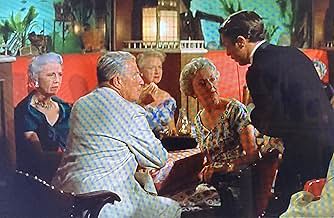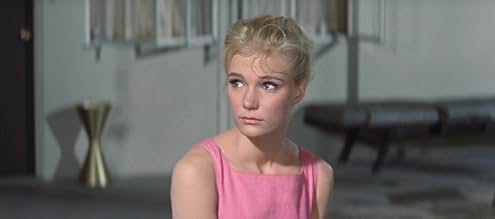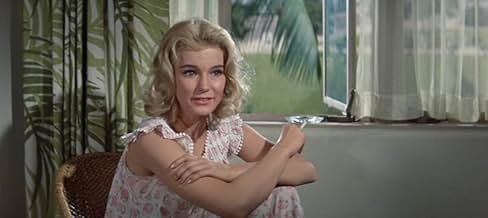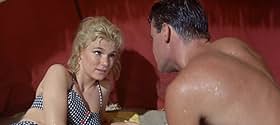CALIFICACIÓN DE IMDb
6.7/10
3.3 k
TU CALIFICACIÓN
Cuatro chicas universitarias muy diferentes conducen a Fort Lauderdale, Florida para las vacaciones de primavera y buscan varias aventuras y romance para ellas mismas.Cuatro chicas universitarias muy diferentes conducen a Fort Lauderdale, Florida para las vacaciones de primavera y buscan varias aventuras y romance para ellas mismas.Cuatro chicas universitarias muy diferentes conducen a Fort Lauderdale, Florida para las vacaciones de primavera y buscan varias aventuras y romance para ellas mismas.
- Dirección
- Guionistas
- Elenco
- Premios
- 2 nominaciones en total
Carol Byron
- Sybil
- (sin créditos)
John Cliff
- Policeman at Hospital
- (sin créditos)
Oliver Cross
- Nightclub Patron
- (sin créditos)
Jack Deery
- Nightclub Patron
- (sin créditos)
Amy Douglass
- Dr. Raunch
- (sin créditos)
Dennis Durney
- Young Man
- (sin créditos)
- Dirección
- Guionistas
- Todo el elenco y el equipo
- Producción, taquilla y más en IMDbPro
Opiniones destacadas
As the saying goes, "it is what it is." Cutting edge (for 1960) teen drama holds up well, with excellent performances by several of the leads. Although it doesn't appear they actually filmed the majority of the film in Florida, there are still some wonderful shots on location in Fort Lauderdale. That community has since banned the Spring Break crowd, but I remember it well in the 60s - 80s, when living in the area.
Many users have complained about the "moralizing" of this film, but I don't find it "preachy." Prentiss is indeed a standout. Connie Francis is adequate, if somewhat masculine, in her first film role. "Narrator" Paul Frees seems to pop up in the oddest places, including The Haunted Mansion ride for Disney.
Many users have complained about the "moralizing" of this film, but I don't find it "preachy." Prentiss is indeed a standout. Connie Francis is adequate, if somewhat masculine, in her first film role. "Narrator" Paul Frees seems to pop up in the oddest places, including The Haunted Mansion ride for Disney.
This film succeeds in the sense that it isn't a stereotypical beach flick. As a current college student, I can attest that it is rather believable, and, oddly enough, some of it applies to college gals today...nearly 40 years later. Actually, WHERE THE BOYS ARE offers the public a fairly realistic, in-depth portrayal of everyday kids in the 60s, as opposed to other beach movies of the period. Simply put: Frankie and Annette had nothing on these gals!
Contrary to what the title may lead one to believe, the focal point is not terribly superficial. Yeah, sure, the girls head to Lauderdale to nab a Yaley or two, but that becomes somewhat secondary to what actually transpires. Whether it was meant to be or not, this film is one of decisions, learning, and friendships that are strengthened due to the experiences four college girls share during Spring Break in Ft. Lauderdale.
The actors themselves are very believable; none of the main players outdo the others. Hart, Mimeux, Francis, and Prentiss do a wonderful job of conveying many different sides to the characters they portray. The supporting cast is equally skilled and effective in varying roles.
Though this isn't Academy Award winning material, it is definitely worth watching!
Contrary to what the title may lead one to believe, the focal point is not terribly superficial. Yeah, sure, the girls head to Lauderdale to nab a Yaley or two, but that becomes somewhat secondary to what actually transpires. Whether it was meant to be or not, this film is one of decisions, learning, and friendships that are strengthened due to the experiences four college girls share during Spring Break in Ft. Lauderdale.
The actors themselves are very believable; none of the main players outdo the others. Hart, Mimeux, Francis, and Prentiss do a wonderful job of conveying many different sides to the characters they portray. The supporting cast is equally skilled and effective in varying roles.
Though this isn't Academy Award winning material, it is definitely worth watching!
Where The Boys Are (1960 Dir. Henry Levin) Fort Lauderdale College Spring Break! Oh Boy! Oh Girl! See where the perennially tan George Hamilton first acquired his swarthy complexion. Also features one of the best '60s light comediennes Paula Prentiss as "Tuggle Carpenter". Lots of talk amongst the girls about how far they should go. Lots of talk amongst the boys about how far they've gotten. A classic American take on life when the air was clean and sex was dirty. Before there was MTV's Spring Break, there was this movie. Great for viewing with mixed company (that's old-fashioned slang for boys and girls together).
Like many others who have commented previously on Where the Boys Are (WTBA), I was initially rather shocked at the film's frank discussion of sex. Once I thought about it more deeply, however, it was the open talk of marriage that was really fresh to my ears. I was born 11 years after this film was released and watching movies like this gives me a unique insight into history that goes well beyond the broad brushes of most sixties reviews and textbooks. Clearly both boys and girls of the time were struggling with the implications of sexuality in relationships - not a whole lot different than today.
What is different about WTBA than the films for young people of today or of my youth (e.g., The Breakfast Club) is the explicit discussion of marriage. In WTBA both the girls and the boys use different levers to try to achieve their ends. The girls use the potential for sex to get the one thing they want - marriage - and the boys use the potential for marriage to get what they are after - sex. I was amazed to hear that all the girls (even the one with an IQ of 138!) were so focussed on catching a husband at 19. None of the movies for youth that I have seen recently even touch the subject of marriage except maybe to joke about it.
While many would argue that no one gets married at 19 anymore, that ultimate end of any relationship still looms out there for young people like a giant prize (or punishment) at the end of dating. The only help I got in seeing young people get together and eventually get married was in The Princess Bride, which could easily be dismissed as fairy tale. I recall in my late teens having to turn to more adult movies like When Harry Met Sally or even Enchanted April to find some guidance for seeing a relationship through to its logical end. Maybe today's youth are skipping over She's All That and going to movies like High Fidelity for similar answers. One would hope so.
So instead of a breezy beach movie I got a social history lesson on the mating rituals of my parents' generation. I hope there's a movie that prompts this kind of discussion for my own kids someday.
What is different about WTBA than the films for young people of today or of my youth (e.g., The Breakfast Club) is the explicit discussion of marriage. In WTBA both the girls and the boys use different levers to try to achieve their ends. The girls use the potential for sex to get the one thing they want - marriage - and the boys use the potential for marriage to get what they are after - sex. I was amazed to hear that all the girls (even the one with an IQ of 138!) were so focussed on catching a husband at 19. None of the movies for youth that I have seen recently even touch the subject of marriage except maybe to joke about it.
While many would argue that no one gets married at 19 anymore, that ultimate end of any relationship still looms out there for young people like a giant prize (or punishment) at the end of dating. The only help I got in seeing young people get together and eventually get married was in The Princess Bride, which could easily be dismissed as fairy tale. I recall in my late teens having to turn to more adult movies like When Harry Met Sally or even Enchanted April to find some guidance for seeing a relationship through to its logical end. Maybe today's youth are skipping over She's All That and going to movies like High Fidelity for similar answers. One would hope so.
So instead of a breezy beach movie I got a social history lesson on the mating rituals of my parents' generation. I hope there's a movie that prompts this kind of discussion for my own kids someday.
Forty-five years have elapsed since its original release, but it is amazing how this 1960 film introduced a particular genre that continues to be produced today granted in a far more explicit manner - the spring-break, beach-party movie where attractive teens go through a sun-drenched mating ritual and somehow love triumphs over carnal knowledge. Back then, the concept didn't seem quite as jaded as it does now, and consequently there is an entertaining naiveté about the timeworn story of four co-eds from a snowy Midwestern college who journey to Ft. Lauderdale for spring break to meet boys.
The plot is based on the then-accepted notion that girls in college are only marking time waiting for husbands to come along, but the journey to that goal depends on the girl. The four in question are Merritt, a smart blonde who is not living up to her academic potential as she questions the moral code around premarital sex; Melanie, so deeply insecure she mistakes sex for love with a less-than-honorable Ivy Leaguer; Tuggle, a tall brunette who zeroes in on an even taller, eccentric hitchhiker; and Angie, the supposedly plain one who gets used to being ignored by men.
Directed in a perfunctory fashion by Henry Levin, this is not the type of movie where you are terribly impressed with the performances, but I have to say the acting is certainly miles above subsequent beach-party movies. Elvis' former leading lady Dolores Hart plays Merritt credibly even as she is being seduced by a youthful George Hamilton wanly playing Ryder, a well-to-do Ivy Leaguer with a conveniently located yacht. As the most troubled of the girls, Yvette Mimieux (always loved her name) accurately captures the constantly forlorn, little-girl-lost state of Melanie, a teen-aged Blanche du Bois in the making.
So pert and charming as Angie, Connie Francis actually seems miscast as a plain-Jane, especially when she sings "Turn on the Sunshine" with a stage polish completely out of character. The standout is Paula Prentiss who portrays Tuggle with her unique personality in full bloom and partnered the first of several times with Jim Hutton as the comically obnoxious TV. She is an under-appreciated comedienne with a loopy charm and vibrantly twangy voice all her own - it's a shame her career never really took off the way it deserved to.
I think the film does make a valid, sometimes even perceptive attempt to address the confusion that Eisenhower-era girls had over sex and love. Girls were expected to function under a double-standard where the only way to attract boys was to have something to offer but at the price of their reputations. This point is hammered home when the tone shifts in the last portion to melodrama. At the same time, the film is filled with predictable comic scenes, including a contrived mêlée in an underwater tank with the zaftig and nasal Barbara Nichols as Esther Williams-wannabe Lola Fandango.
Prentiss offers her services and remembrances to the alternate audio commentary track on the DVD, which also comes with a looking-back featurette which includes interviews with Prentiss and Francis. Who knew this film would launch a hundred imitations? The minute you hear Francis sing the title tune, it is hard for a baby boomer not to get nostalgic. If you have an interest in understanding the mid-century moral code enforced upon the youth of America, especially girls, I can think of worse films to see.
The plot is based on the then-accepted notion that girls in college are only marking time waiting for husbands to come along, but the journey to that goal depends on the girl. The four in question are Merritt, a smart blonde who is not living up to her academic potential as she questions the moral code around premarital sex; Melanie, so deeply insecure she mistakes sex for love with a less-than-honorable Ivy Leaguer; Tuggle, a tall brunette who zeroes in on an even taller, eccentric hitchhiker; and Angie, the supposedly plain one who gets used to being ignored by men.
Directed in a perfunctory fashion by Henry Levin, this is not the type of movie where you are terribly impressed with the performances, but I have to say the acting is certainly miles above subsequent beach-party movies. Elvis' former leading lady Dolores Hart plays Merritt credibly even as she is being seduced by a youthful George Hamilton wanly playing Ryder, a well-to-do Ivy Leaguer with a conveniently located yacht. As the most troubled of the girls, Yvette Mimieux (always loved her name) accurately captures the constantly forlorn, little-girl-lost state of Melanie, a teen-aged Blanche du Bois in the making.
So pert and charming as Angie, Connie Francis actually seems miscast as a plain-Jane, especially when she sings "Turn on the Sunshine" with a stage polish completely out of character. The standout is Paula Prentiss who portrays Tuggle with her unique personality in full bloom and partnered the first of several times with Jim Hutton as the comically obnoxious TV. She is an under-appreciated comedienne with a loopy charm and vibrantly twangy voice all her own - it's a shame her career never really took off the way it deserved to.
I think the film does make a valid, sometimes even perceptive attempt to address the confusion that Eisenhower-era girls had over sex and love. Girls were expected to function under a double-standard where the only way to attract boys was to have something to offer but at the price of their reputations. This point is hammered home when the tone shifts in the last portion to melodrama. At the same time, the film is filled with predictable comic scenes, including a contrived mêlée in an underwater tank with the zaftig and nasal Barbara Nichols as Esther Williams-wannabe Lola Fandango.
Prentiss offers her services and remembrances to the alternate audio commentary track on the DVD, which also comes with a looking-back featurette which includes interviews with Prentiss and Francis. Who knew this film would launch a hundred imitations? The minute you hear Francis sing the title tune, it is hard for a baby boomer not to get nostalgic. If you have an interest in understanding the mid-century moral code enforced upon the youth of America, especially girls, I can think of worse films to see.
¿Sabías que…?
- TriviaPaula Prentiss signed a seven-year contract with MGM in 1960 when she was cast in this movie. She was living with boyfriend actor Richard Benjamin at the time, which was taboo in those days, and the studio didn't want her traveling on promotion junkets with a man who wasn't her spouse. So they asked the two to wed, though not before milking the wedding for publicity. Prentiss had to make long-distance calls to gossip columnists Hedda Hopper and Louella Parsons just before the ceremony, according to People. They were married by a New York judge on Oct. 26, 1961. They are still together as of 2022.
- ErroresWhen the kids are first introduced to Basil's jazz band, hundreds of kids rush to the bar, with the main characters in the rear. Yet, the main characters somehow manage to find one of the few tables in the bar.
- Citas
Police Captain: Wait a minute! Haven't I seen you in here before?
Lola Fandango: Just once, and it was purely by accident. The night my strap broke?
[she shows her very revealing top]
- Créditos curiosos"and introducing Connie Francis"
- ConexionesFeatured in Where the Boys Were: A Retrospective (2004)
- Bandas sonorasWhere the Boys Are
Words by Howard Greenfield
Music by Neil Sedaka
Performed by Connie Francis (uncredited)
Courtesy of Nevins - Kirshner
Selecciones populares
Inicia sesión para calificar y agrega a la lista de videos para obtener recomendaciones personalizadas
Detalles
- Fecha de lanzamiento
- País de origen
- Sitios oficiales
- Idioma
- También se conoce como
- Where the Boys Are
- Locaciones de filmación
- Fort Lauderdale, Florida, Estados Unidos(some exteriors)
- Productora
- Ver más créditos de la compañía en IMDbPro
- Tiempo de ejecución
- 1h 39min(99 min)
- Relación de aspecto
- 2.35 : 1
Contribuir a esta página
Sugiere una edición o agrega el contenido que falta






























